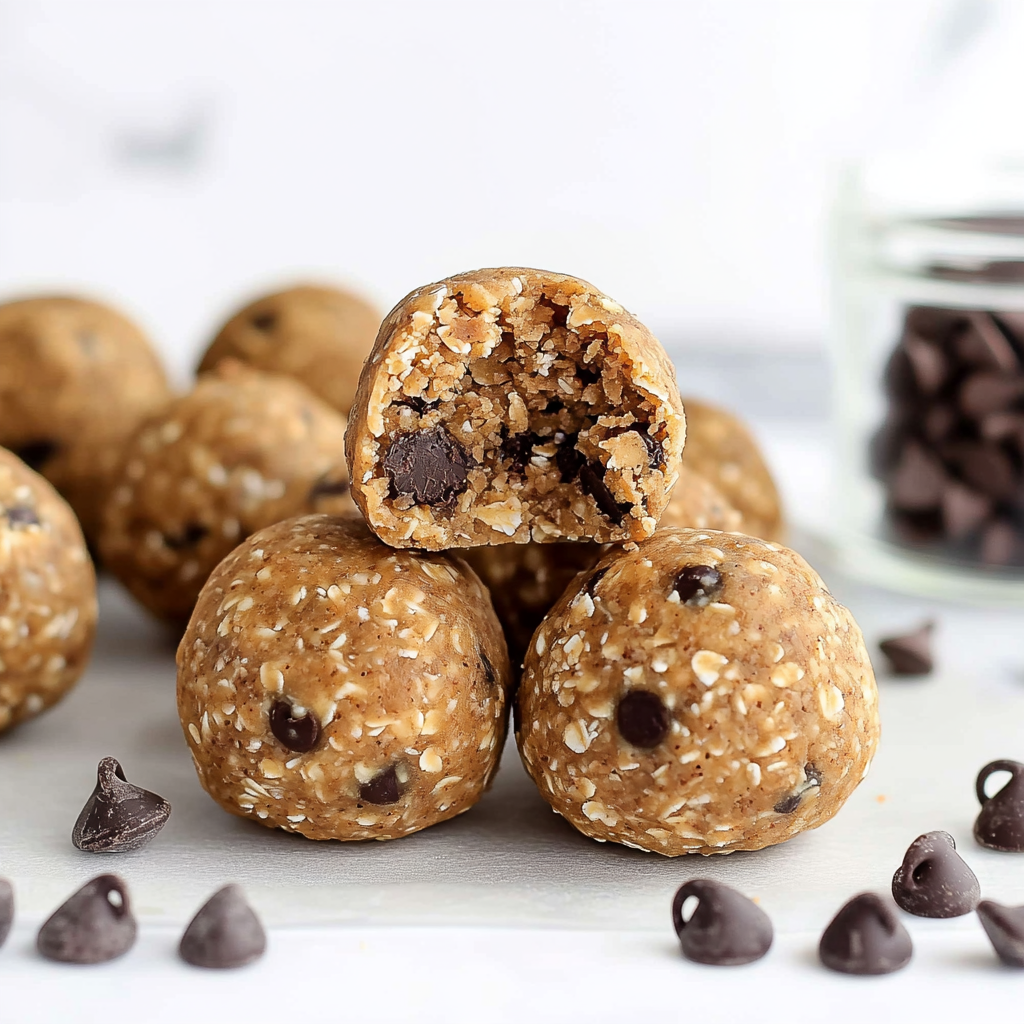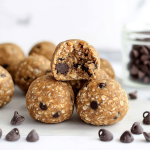Advertisement
Peanut Butter Protein Balls: The Ultimate No-Bake Energy Snack
If you’re looking for a quick, delicious, and protein-packed snack, these Peanut Butter Protein Balls are the perfect solution! Made with just 6 simple ingredients, requiring no food processor, and packing 9g of protein per ball, they’re an ideal grab-and-go treat for busy mornings, post-workout recovery, or a midday energy boost.
In this comprehensive guide, we’ll walk you through:
✅ The best ingredients for the perfect texture & flavor
✅ Step-by-step instructions (with photos!)
✅ Storage tips to keep them fresh
✅ Nutritional benefits & customization ideas
✅ Frequently asked questions
Let’s dive in!
Why You’ll Love These Peanut Butter Protein Balls
Before we get into the recipe, here’s why these peanut butter protein balls are a must-try:
✔ No baking required – Ready in 20 minutes
✔ High in protein (9g per ball!)
✔ Naturally sweetened with honey
✔ Packed with fiber from oats & chia seeds
✔ Great for meal prep – Stays fresh for a week in the fridge or 3 months in the freezer
✔ Kid-friendly & customizable
Whether you need a pre-workout boost, a healthy dessert, or a quick breakfast, these protein balls deliver!
Ingredients for Peanut Butter Protein Balls
Here’s what you’ll need (exact measurements in the recipe card below):
- 1 cup drippy all-natural peanut butter (the runnier, the better for binding)
- 1/3 cup vanilla protein powder (we recommend Garden of Life or collagen-based options)
- 1/2 cup rolled oats (for texture & fiber)
- 1 tablespoon chia seeds (for omega-3s & extra crunch)
- 2 tablespoons honey (or maple syrup for vegan option)
- 1/4 cup mini chocolate chips (because chocolate makes everything better!)
- 1-4 teaspoons water (as needed for consistency)
Ingredient Substitutions & Tips
- Peanut Butter Alternatives: Almond butter, cashew butter, or sunflower seed butter work too.
- Protein Powder: Whey, plant-based, or collagen all work—adjust water as needed.
- Sweetener Swap: Agave or maple syrup for a vegan version.
- Add-Ins: Flaxseeds, coconut flakes, or dried fruit for extra flavor.
Step-by-Step Instructions (With Photos!)
Step 1: Mix Dry Ingredients
In a medium bowl, combine:
- Peanut butter
- Protein powder
- Rolled oats
- Chia seeds
- Honey
- Mini chocolate chips
Advertisement

Step 2: Combine & Adjust Consistency
- Use a wooden spoon (or your hands) to mix.
- Slowly add water (1 tsp at a time) until the dough holds together.
💡 Pro Tip: If using whey or collagen protein, you may need extra powder instead of water.
Step 3: Roll Into Balls
- Use a 1-tablespoon cookie scoop for even portions.
- Roll between your palms until smooth.
- Should make 14-16 balls.

Step 4: Chill & Store
- Refrigerate for 1 hour to firm up.
- Store in an airtight container for:
- 1 week in the fridge
- 3 months in the freezer
Nutritional Benefits of Peanut Butter Protein Balls
Each ball contains:
| Nutrient | Amount |
|---|---|
| Calories | 141 kcal |
| Carbs | 8g |
| Protein | 9g |
| Fat | 7g |
| Fiber | 2g |
| Sugar | 3g |
Why These Are a Healthy Choice
✅ Protein-packed – Supports muscle recovery & keeps you full.
✅ Healthy fats – From peanut butter for sustained energy.
✅ Fiber-rich – Aids digestion & blood sugar balance.
✅ No refined sugar – Naturally sweetened with honey.
5 Delicious Variations to Try
Want to switch things up? Here are 5 tasty twists:
1. Chocolate Lover’s Version
- Add 1 tbsp cocoa powder + extra chocolate chips.
2. Cookie Dough Style
- Use vanilla extract + extra oats for a cookie-like taste.
3. Tropical Vibes
- Swap chocolate chips for dried coconut & pineapple bits.
4. Nut-Free Option
- Use sunflower seed butter instead of peanut butter.
5. Superfood Boost
- Add hemp seeds, flaxseeds, or maca powder.
The Science Behind Peanut Butter Protein Balls as a Perfect Post-Workout Snack
Peanut butter protein balls have become a staple for fitness enthusiasts, and for good reason. Their unique nutritional profile makes them an ideal post-workout recovery food. Let’s examine the science behind why these no-bake treats are so effective for muscle recovery and energy replenishment.
The Protein Advantage
The 9g of protein per ball comes from two primary sources:
- Peanut Butter – Provides plant-based protein (about 4g per tablespoon)
- Protein Powder – Adds concentrated protein (typically 15-25g per scoop)
This combination delivers both fast-digesting (from the protein powder) and slow-digesting (from the peanut butter) proteins, creating a sustained release of amino acids to your muscles. Studies show this dual-phase protein delivery enhances muscle protein synthesis more effectively than single-source proteins.
Optimal Carb-to-Protein Ratio
With 8g carbs and 9g protein per ball, these snacks hit the ideal 3:4 carb-to-protein ratio recommended for post-workout recovery. The oats provide complex carbohydrates that:
- Replenish glycogen stores
- Prevent muscle breakdown
- Provide steady energy without blood sugar spikes
Electrolyte Replenishment
The natural peanut butter and chia seeds contain:
- Potassium – Helps prevent muscle cramps
- Magnesium – Reduces exercise-induced inflammation
- Sodium – Replaces what’s lost through sweat
Anti-Inflammatory Benefits
The omega-3 fatty acids from chia seeds help reduce exercise-induced inflammation. Research shows athletes who consume omega-3s recover faster between training sessions.
Practical Benefits for Athletes
- Portable – Easy to take to the gym
- No refrigeration needed for short-term storage
- Customizable for different training needs (add more protein powder for strength athletes or more oats for endurance athletes)
The Psychology of Snacking – Why Peanut Butter Protein Balls Satisfy Cravings Better Than Processed Alternatives
Understanding the psychological aspects of snacking helps explain why peanut butter protein balls are more satisfying than commercial protein bars or sugary snacks.
The Texture Factor
These balls provide three crucial texture elements that signal satisfaction to the brain:
- Creaminess from peanut butter
- Chewiness from oats
- Crunch from chia seeds and chocolate chips
Research shows that foods with multiple textures are perceived as more satisfying and flavorful than single-texture foods.
Flavor Balancing Act
The combination of:
- Sweet (honey)
- Salty (peanut butter)
- Bitter (dark chocolate)
creates what food scientists call “dynamic contrast,” which keeps your taste buds engaged and prevents flavor fatigue.
The Psychology of Portion Control
The pre-portioned ball shape:
- Creates natural stopping points
- Provides visual cues for appropriate portion sizes
- Reduces mindless overeating common with bagged snacks
The Homemade Advantage
Studies show that when people prepare their own snacks:
- They feel more connected to the food
- Experience greater satisfaction
- Are less likely to overindulge later
Blood Sugar Stability and Mood
The balanced macronutrient profile helps maintain steady blood sugar levels, which:
- Prevents energy crashes
- Reduces irritability
- Minimizes subsequent cravings
The Environmental and Economic Impact of Choosing Homemade Protein Balls
Beyond personal health benefits, choosing homemade peanut butter protein balls has significant environmental and economic advantages worth considering.
Reduced Packaging Waste
Commercial protein bars generate:
- Individual wrappers (often non-recyclable)
- Outer packaging
- Shipping materials
By comparison, homemade balls can be stored in reusable containers, eliminating single-use packaging. If every American replaced one protein bar per week with homemade balls, it would eliminate over 1 billion wrappers annually.
Lower Carbon Footprint
The simple ingredients have:
- Fewer processing steps than commercial bars
- Shorter supply chains (many ingredients can be bought in bulk)
- Less energy-intensive production
Economic Benefits
Cost Comparison (per serving):
- Commercial protein bars: 2.50−4.00
- Homemade protein balls: 0.50−0.75
Annual Savings Potential:
For someone eating one daily:
- Commercial: 912−1,460/year
- Homemade: 182−273/year
Supporting Sustainable Agriculture
By choosing ingredients wisely, you can:
- Select fair trade peanut butter
- Use organic oats
- Opt for sustainably sourced chocolate
Reduced Food Waste
Homemade balls allow you to:
- Use up pantry ingredients before they expire
- Customize quantities to your needs
- Easily repurpose leftovers (crumble over yogurt or oatmeal)
Community Impact
Making your own snacks:
- Supports local health food stores
- Reduces demand for industrially produced foods
- Sets a positive example for children about sustainable eating
FAQs About Peanut Butter Protein Balls
1. Can I use a food processor?
Yes, but it’s not necessary! Mixing by hand works perfectly.
2. Why are my protein balls crumbly?
- Not enough peanut butter or water.
- Try adding 1 tsp melted coconut oil for extra binding.
3. Can I make these vegan?
Yes! Use plant-based protein powder & maple syrup instead of honey.
4. How long do they last?
- Fridge: 1 week
- Freezer: 3 months (thaw before eating)
5. Can I use quick oats?
Yes, but rolled oats give better texture.
Peanut Butter Protein Balls: The Ultimate No-Bake Energy Snack
These peanut butter protein balls remind me of my grandma’s kitchen—always full of love, laughter, and the sweet smell of peanut butter. Quick to make and packed with goodness, they’re perfect for a healthy snack on the go or a treat with your afternoon tea. I make a batch every Sunday and they’re gone before Wednesday! Try them out and let me know how fast they disappear at your place!
- Prep Time: 20 mins
- Total Time: 20 mins
Ingredients
- 1 cup drippy all-natural peanut butter
- ⅓ cup vanilla protein powder (we recommend Garden of Life)
- ½ cup rolled oats
- 1 tbsp chia seeds
- 2 tbsp honey
- ¼ cup mini chocolate chips
- 1–4 tsp water (as needed)
Instructions
- Mix Ingredients: In a medium bowl, combine peanut butter, protein powder, oats, chia seeds, honey, and chocolate chips.
- Adjust Consistency: Use a wooden spoon (or your hands) to mix. Gradually add water (1 tsp at a time) until the dough holds together without being too sticky.
- Form Balls: Scoop dough with a 1-tbsp cookie scoop, roll into balls, and place on a tray.
- Chill & Store: Refrigerate for 1 hour to firm up. Store in the fridge for up to 1 week or freeze for up to 3 months.
Notes
- Protein Powder Variations: Whey or collagen-based powders may need extra liquid. If using Bulletproof or Vital Proteins, you might need 2.5 tbsp more powder and no water.
- Too Dry? Add more peanut butter or honey.
- Too Sticky? Add more oats or protein powder.
- Customize: Swap chocolate chips for raisins, coconut, or flaxseeds.
Nutrition
- Calories: 141 kcal per serving
- Sugar: 3g
- Fat: 7g
- Carbohydrates: 8g
- Fiber: 2g
- Protein: 9g
Final Thoughts
These Peanut Butter Protein Balls are the perfect snack for anyone needing a quick, healthy energy boost. With minimal prep, no baking, and endless customization options, they’re a must-try for fitness lovers, busy parents, and meal-prep enthusiasts.

